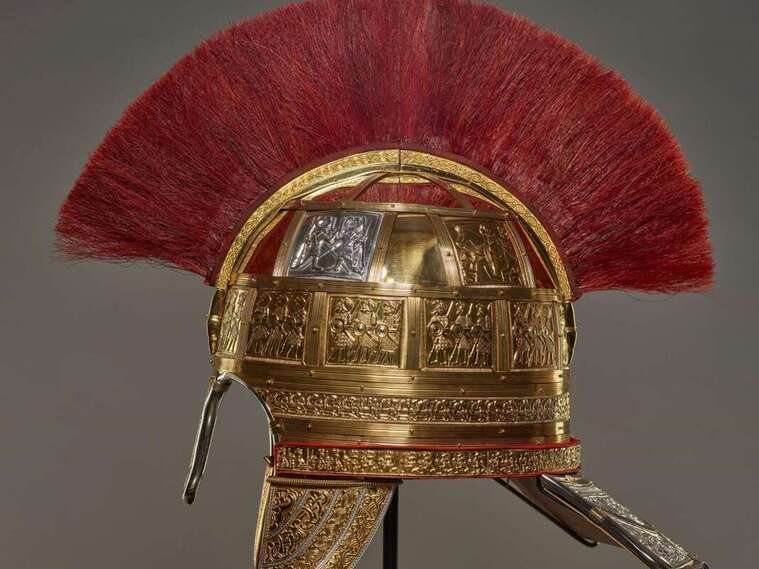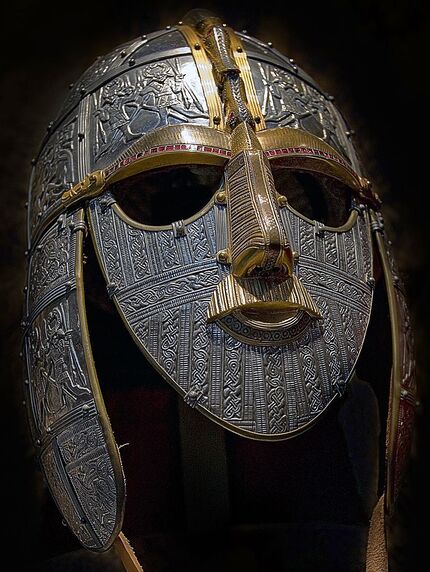Anglo-Saxon Art & Craft Alan Payne and Jonathan Parkhouse June 2020
It isn’t easy to identify the character of the Anglo-Saxons. On one hand there is the evidence of Gildas of their ruthless ferocity and on the other hand there are the treasures they left behind, objects of intricate beauty at Sutton Hoo and the Staffordshire Hoard. One of the difficulties is that we know so little about their lifestyles and their domestic existence.
Saxon Settlements
There seems to be a mis-match between archaeological finds and the literature which exists describing Saxon halls. We assume that these structures were large because they were built by and for an elite. They have been depicted as palaces holding two or three hundred people where the importance of the lord could be witnessed and appreciated. There is a description of heorot (a mead hall) in Beowulf, where it was the central location of the poem. The hall was large enough for Beowulf to receive a gift of eight horses, with gold headgear and the structure accommodated, fed and slept all the warriors in a warm, friendly atmosphere: Inside Heorot there was nothing but friendship. It was also a court of law and a place to express loyalty and receive the most beautiful gifts of appreciation.
Admittedly a long way from Box, a few structures have been found like this, such as the aisled hall at Yeavering and a complex of buildings at Lyminge, Kent. These are conspicuous in the landscape with formal layouts, often deliberately planned to standardised units of measurement and representing ostentatious consumption of resources.
Many domestic houses were small, simple, rectangular structures, modest farmhouses, which archaeologists have identified through the soil deposits of wooden postholes supporting the thatch roof and compacted floor layers in which the organic materials have rotted away.[1] In addition to these structures, archaeologists have found evidence of smaller, sunken-featured buildings called grubenhäuser believed to be craft workshops or storage buildings. Common in the south and east of the country and all over the continent, none have been found in the west of the country, including western Wiltshire.[2] Again, evidence that Germanic culturalisation came later to our area in the seventh century.
Saxon Settlements
There seems to be a mis-match between archaeological finds and the literature which exists describing Saxon halls. We assume that these structures were large because they were built by and for an elite. They have been depicted as palaces holding two or three hundred people where the importance of the lord could be witnessed and appreciated. There is a description of heorot (a mead hall) in Beowulf, where it was the central location of the poem. The hall was large enough for Beowulf to receive a gift of eight horses, with gold headgear and the structure accommodated, fed and slept all the warriors in a warm, friendly atmosphere: Inside Heorot there was nothing but friendship. It was also a court of law and a place to express loyalty and receive the most beautiful gifts of appreciation.
Admittedly a long way from Box, a few structures have been found like this, such as the aisled hall at Yeavering and a complex of buildings at Lyminge, Kent. These are conspicuous in the landscape with formal layouts, often deliberately planned to standardised units of measurement and representing ostentatious consumption of resources.
Many domestic houses were small, simple, rectangular structures, modest farmhouses, which archaeologists have identified through the soil deposits of wooden postholes supporting the thatch roof and compacted floor layers in which the organic materials have rotted away.[1] In addition to these structures, archaeologists have found evidence of smaller, sunken-featured buildings called grubenhäuser believed to be craft workshops or storage buildings. Common in the south and east of the country and all over the continent, none have been found in the west of the country, including western Wiltshire.[2] Again, evidence that Germanic culturalisation came later to our area in the seventh century.
|
Sutton Hoo Treasures The discovery of the Sutton Hoo treasure in Suffolk was made just before the Second World War in 1939. Thanks to the determination of the owner of the land, Mrs Edith Pretty, the burial mounds on the site were excavated by a local archaeologist, Basil Brown. Much work has been undertaken since then, including by Professor Martin Carver in the 1980s and more recently. In one of the eighteen mounds a family was buried with finds including a man, woman, horse and possibly a dog. There are other interesting finds, such as a young man buried in an oak coffin with his horse and his most precious objects, his sword, spears, horse bridle, cauldron and bowl. Perhaps the most significant part of the find was the ship burial itself although the treasures certainly belonged to an exceptional person, leading some historians to compared the finds to the words of Beowulf, particularly the military lifestyle and weapon goods. Left: Sutton Hoo helmet (800px-Sutton_Hoo_helmet_reconstructed_Wiki_By Gernot Keller) |
Some of the key issues which emerge from the discovery are the range of connections, including diplomatic contact and goods derived from trade or exchange. The cultural influences demonstrated by the finds indicate that 7th century England was not a backwater at the edge of the world. The sheer scale of conspicuous consumption is astounding with valuable objects being deliberately placed beyond reach. Professor Carver suggested that the flamboyance of the ship-burial and the ritual which must have taken place is a distinct signal about power and perhaps a defiantly pagan symbolic act in the face of the new religion. The use of the ship may have been a conscious re-statement of an origin-myth, with clear connections to Scandinavia.
Unfortunately, no evidence of a body has been uncovered in the main site, leading some to speculate that it was a cenotaph. More probably the body has disappeared in the acidic sandy soils. There’s a general consensus that the occupant was one of the Wuffinga dynasty of the East Angles, most likely Raedwald (599-624) but possibly one of his sons, Sigebehrt or Eorpwald. Raedwald was (probably) baptised about 604, but seems to have been somewhat ‘off-message’ as according to Bede he established an altar to the new deity alongside his existing ones.
Staffordshire Hoard
The hoard found near Lichfield, Staffordshire, in 2009 was the largest ever discovered with nearly 3,500 pieces of jewellery and silverware recovered. The inscriptions on many of them are minute, ornate depictions of animals, birds and snakes. Almost all the pieces were of a military nature, not domestic goods and, unusually, no female elite objects.
When the hoard came to Bristol Museum a few years ago, the touring items largely comprised sword pommels, the size and shape of a Scout’s toggle, which you looked at through a magnifying glass. You get some idea of the range and variety at http://www.staffordshirehoard.org.uk/ These pieces have been dated 650-675, though some items are considerably older. Conflict between Mercian and Northumbrian kingdoms during this period may provide a context for deposition.
Most of the gold is very high quality 18-carat, probably derived from the eastern Byzantine Roman empire, melted down and refashioned for Saxon taste. This begs the question of what commodity the gold was exchanged for? One may surmise that slaves were involved and that the source of slaves was warfare and raiding. The garnets in the Staffordshire hoard came from even further afield. Analysis shows sources in India and Sri Lanka, although towards the end of the 6th century there seems to have been some constriction in the South Asian supply and more reliance on Czechoslovakian sources. Both gold and garnets could be extensively recycled.
There are few overtly Christian objects but those that are present are extremely interesting. They include a pectoral cross, a processional cross and a gold strip with engraved lettering forming a Latin inscription. The craftsman may have been only semi-literate and the inscription has been deciphered as: Rise up O Lord, and let thine enemies be scattered and those who hate thee flee from thy face. (Numbers 10,35). The gold strip had been folded in half; perhaps it came from a reliquary, even one carried into battle as a religious talisman.
The objects raise many questions: Were they simply bling used to reward followers for loyalty and service? As they were all damaged or incomplete, were they deliberately killed before deposition? Were they destined for recycling, but hastily buried? The Christian objects are in fact the oldest known artefacts of the Anglo-Saxon church.
Unfortunately, no evidence of a body has been uncovered in the main site, leading some to speculate that it was a cenotaph. More probably the body has disappeared in the acidic sandy soils. There’s a general consensus that the occupant was one of the Wuffinga dynasty of the East Angles, most likely Raedwald (599-624) but possibly one of his sons, Sigebehrt or Eorpwald. Raedwald was (probably) baptised about 604, but seems to have been somewhat ‘off-message’ as according to Bede he established an altar to the new deity alongside his existing ones.
Staffordshire Hoard
The hoard found near Lichfield, Staffordshire, in 2009 was the largest ever discovered with nearly 3,500 pieces of jewellery and silverware recovered. The inscriptions on many of them are minute, ornate depictions of animals, birds and snakes. Almost all the pieces were of a military nature, not domestic goods and, unusually, no female elite objects.
When the hoard came to Bristol Museum a few years ago, the touring items largely comprised sword pommels, the size and shape of a Scout’s toggle, which you looked at through a magnifying glass. You get some idea of the range and variety at http://www.staffordshirehoard.org.uk/ These pieces have been dated 650-675, though some items are considerably older. Conflict between Mercian and Northumbrian kingdoms during this period may provide a context for deposition.
Most of the gold is very high quality 18-carat, probably derived from the eastern Byzantine Roman empire, melted down and refashioned for Saxon taste. This begs the question of what commodity the gold was exchanged for? One may surmise that slaves were involved and that the source of slaves was warfare and raiding. The garnets in the Staffordshire hoard came from even further afield. Analysis shows sources in India and Sri Lanka, although towards the end of the 6th century there seems to have been some constriction in the South Asian supply and more reliance on Czechoslovakian sources. Both gold and garnets could be extensively recycled.
There are few overtly Christian objects but those that are present are extremely interesting. They include a pectoral cross, a processional cross and a gold strip with engraved lettering forming a Latin inscription. The craftsman may have been only semi-literate and the inscription has been deciphered as: Rise up O Lord, and let thine enemies be scattered and those who hate thee flee from thy face. (Numbers 10,35). The gold strip had been folded in half; perhaps it came from a reliquary, even one carried into battle as a religious talisman.
The objects raise many questions: Were they simply bling used to reward followers for loyalty and service? As they were all damaged or incomplete, were they deliberately killed before deposition? Were they destined for recycling, but hastily buried? The Christian objects are in fact the oldest known artefacts of the Anglo-Saxon church.
References
[1] See Helena Hamerow, Rural settlements and society in Anglo-Saxon England, 2012, Oxford University Press and John Blair, Building Anglo-Saxon England, 2018, Princeton University Press.
[2] Bruce Eagles, Bruce Eagles, “Anglo-Saxon Presence and Culture in Wiltshire, AD 450-c675”, in Roman Wiltshire and After: papers in honour of Ken Annable (editor Peter Ellis), 2001, p.200
[1] See Helena Hamerow, Rural settlements and society in Anglo-Saxon England, 2012, Oxford University Press and John Blair, Building Anglo-Saxon England, 2018, Princeton University Press.
[2] Bruce Eagles, Bruce Eagles, “Anglo-Saxon Presence and Culture in Wiltshire, AD 450-c675”, in Roman Wiltshire and After: papers in honour of Ken Annable (editor Peter Ellis), 2001, p.200

